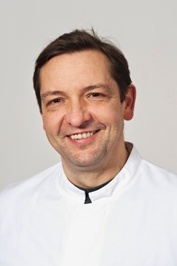A better sleep in the operating theatre
Xenon anaesthesia not only preserves the heart and circulation but also prevents post-operative delirium. The high cost of the gas is made up for by a shorter length of sta.
Report: Holger Zorn


Another operation – the third in three years – this time, to replace the artificial hip of the 87-year-old patient. The old lady is scared, not so much of the pain – with which she believes she can cope – but the anaesthetic: She has twice spent several days in a state of confusion and delirium after anaesthesia and had been tied to the bed to avoid a fall and breakage of anything. During that time she did not know where she was, but later realised. Embarrassed, she never wants to repeat those events.
Matthias Reyle-Hahn, Consultant at the Evangelisches Waldkrankenhaus Spandau, often hears such stories. For ten years he has been offering a particularly gentle anaesthesia with the noble gas Xenon. US frogmen discovered its narcotic effect when they tested noble gases as oxygen additives. Xenon was licensed as a narcotic substance in Germany in 2005; Air Liquide produces and markets it under the trade name LENOXe. Its effect is analgesic as well as hypnotic and it has a rapid onset and offset due to its low blood-gas-partition coefficient. The patient’s blood pressure remains stable, the heart’s pumping function is not impaired and the patient quickly wakes from the anaesthetic.
Many high risk patients make their way to this hospital on the outskirts of Berlin, including those severe heart disease, multiple allergies, or a hereditary predisposition for overheating of the body (malignant hyperthermia), in which the muscles react too strongly to conventional anaesthetics. In around 90% of patients that has a fatal outcome. Other typical patients are older people who have already experienced confusion after anaesthetic administration. ‘In ten years, we’ve not seen a single case of severe delirium after a Xenon anaesthetic,’ says Dr Reyle-Hahn. However, it cannot be completely ruled out despite this experience: ‘It is possible that very light forms may be overlooked.’ This should now be researched in university hospitals on a larger number of patients.
Some time ago the Charité Berlin began a trial of this narcotic gas in the urology and gynaecology departments. ‘The stable circulation under Xenon can deceive doctors about the patient’s real condition,’ says Professor Claudia Spies, director of the Clinic for Anaesthesiology, with a focus on surgical intensive care medicine. ‘Therefore we started the trials in a very clear area; from next year we will also be using Xenon in general surgery.’
The planned study is to explain why Xenon can prevent a severe delirium after surgery in older patients. Animal experiments point towards the fact that Xenon protects the brain cells (source: Ann Neurol. 2011 Jul; 70 (1) :133-50). That this effect also works in humans was shown last year by Marianne Thoresen, James Tooley and John Dingley at St. Michael’s Hospital in Bristol. They saved a newborn baby from severe brain damage by administering a combination of mild therapeutic hypothermia and a Xenon anaesthetic. ‘These preserving characteristics of Xenon are also of interest for anaesthesia in older patients,’ Prof. Spies believes.
However, the gas is rare and only occurs in traces of the earth’s atmosphere. Its manufacture is complex and energy-intensive. A two-hour anaesthetic requires around 16 litres of Xenon. Depending on the length of the operation this costs between €150 and €300 – and therefore ten times as much as a conventional anaesthetic with Isoflurane or Sevoflurane. Moreover, there are now only two manufacturers worldwide who offer anaesthesia workstations that can be used with Xenon. Nonetheless, Dr Reyle-Hahn sees an economic potential for the user: ‘It is the best anaesthetic we can currently offer,’ he says, ‘and it does pay off.’ Even after 12-16 hour operations patients wake up within minutes and are responsive. As fewer complications occur during surgery the length of hospital stay is also shortened.
20.10.2011











